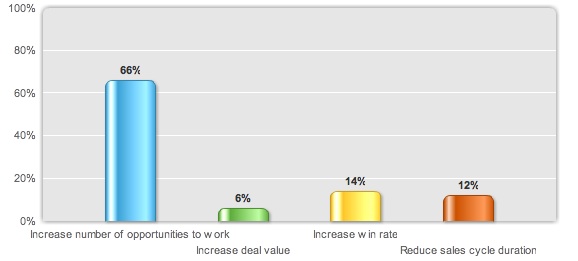There are only four factors that impact how much you sell. I use a term called the Sales Velocity Equation and it’s pretty simple. It goes like this. Your Sales Velocity is a function of (A) the number of sales opportunities you work, (B) the average deal value, (C) your win rate and (D) the length of the sales cycle. Simply put; you want to increase A,B and C and reduce D. If you increase A, B and C by 10% and reduce D by 10%, then you increase your sales velocity by 47%. Go on, do the math – it works out.
So, before you read the rest of this blog post, stop and think for a minute, and pick from the following four options the one where you spend most of your time.
- Increase number of opportunities
- Increase average deal value
- Increase win rate
- Reduce sales cycle
I just ran a survey on this – and unfortunately most people are focusing most of their time on getting more opportunities and not trying to maximize the return from the opportunities they have. I suspect that increasing the number of opportunities is, for many sales people, the only activity that gets any real attention.
 The problem with this is that if you focus most of your time on filling the pipeline (not an unimportant matter) you’ve less time to increase the chance of winning the deals you have, maximizing the value from those deals, or reducing the sales cycle.
The problem with this is that if you focus most of your time on filling the pipeline (not an unimportant matter) you’ve less time to increase the chance of winning the deals you have, maximizing the value from those deals, or reducing the sales cycle.
In many cases, this behavior is reinforced by sales management whose primary measure is ’sales activity’. Questions like “How many calls did you make this week?” or “How much did you add to your pipeline last month?” drive very inefficient behavior.
From the salesperson’s perspective, in many ways adding new opportunities to the pipeline is the easiest thing to do, particularly if that’s how you’re being measured.
- No one said they had to be qualified right? Early qualification would only reduce the size of the pipeline.
- No one said they need to be deals that you actually have a chance of winning?
- You didn’t need to challenge the prospect to uncover how you could really add value (removing price sensitivity and improving your average deal size).
- There was no need to ask really tough questions to understand the customer’s buying process so that you could align your selling activity, or negotiate access to the real decision makers to increase your win rate.
- And you didn’t need to take control of the sale, or agree a joint selling/buying plan with the prospect, where you could in fact guide the progress and shorten the sales cycle.
In fact, you didn’t really need any courage at all.
Of course I understand the need to constantly add new opportunities to your pipeline, but indulge me for a minute. Let’s consider it’s not the only thing you should focus on. What happens if you don’t add new opportunities? Does it mean that your sales velocity grinds to a halt? – well not necessarily.
If we apply the sales velocity equation and assume that the number of opportunities stays static, but that you do manage to increase the average deal size and win rate by 10%, and reduce the length of the sales cycle by 10%, your sales velocity would improve by 34%.
So, this week I’d like to give you a challenge. Ask yourself what you can do with the deals you have in your pipeline to impact your deal size, win rate, and sales cycle duration. You might be surprised at the results. Come back and let me know.




